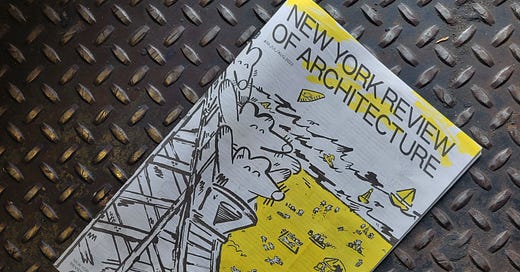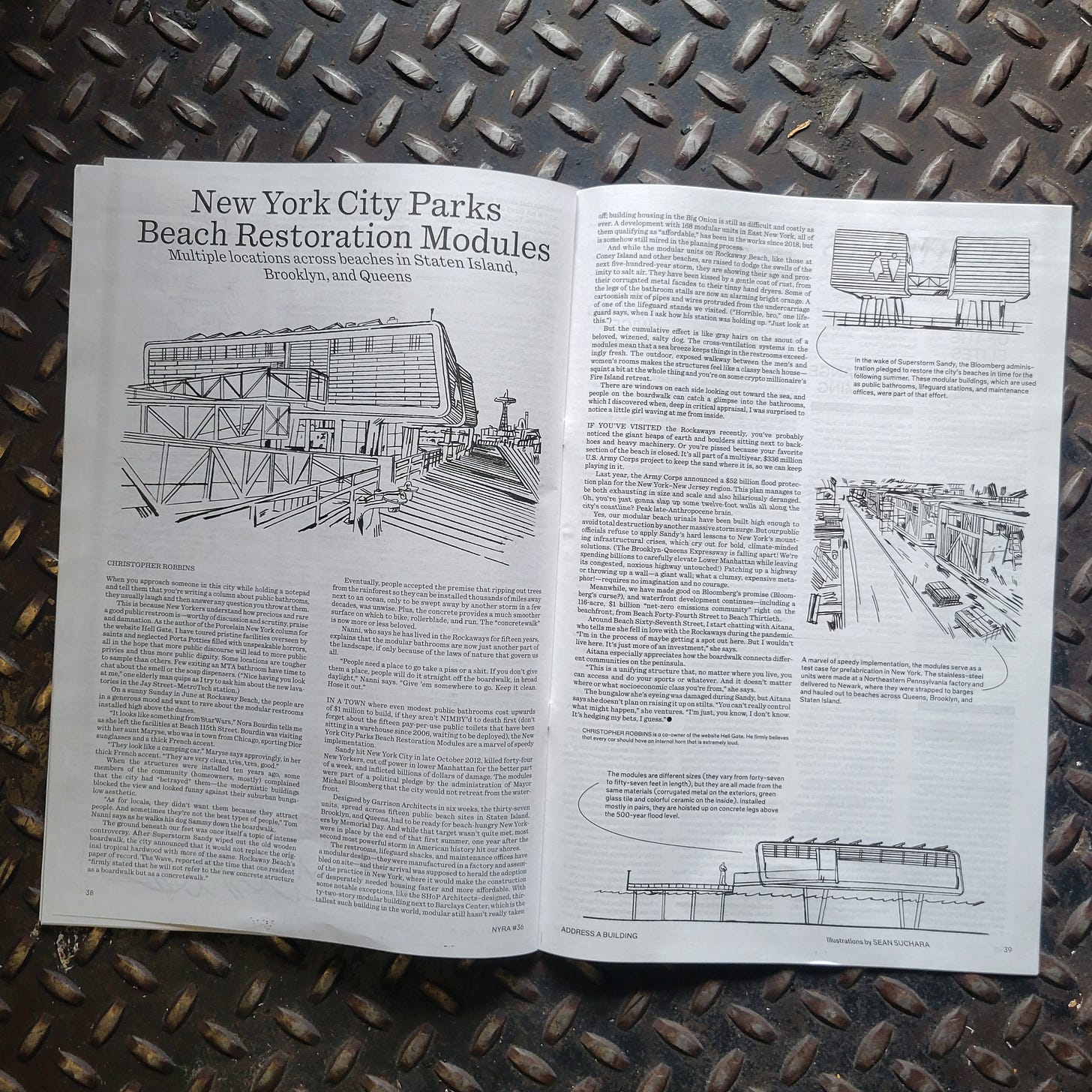An architect of some repute wrote to us recently regarding our last issue with a friendly complaint about the length. We regret that our latest, #36, will do nothing to assuage his mild irritation. Unlike in nearly every architectural publication, texts and images in the New York Review of Architecture do not vie for the reader’s attention. Indeed, there is only photograph in the current issue—depicting a dilapidated movie theater turned cruising spot in Jackson Heights—and it comes courtesy of the documentarian John Wilson, a nonarchitect who might just be a great architectural critic. (The suggestion, made in an interview with NYRA, prompted the following response from Wilson: “That’s cool.”) The same might be said about another issue contributor—the novelist Zain Khalid, who reviews a book about buildings and the downfall of their makers. Christopher Robbins, a co-owner of the website Hell Gate, is no architect either, though that didn’t stop him from critically assessing a series of public restrooms in our pages. Of course, in opening the door to criticism—of buildings, public space, “the discipline”—we don’t mean to disregard faithful practitioners of the form, as contributions by Mimi Zeiger, Christopher Hawthorne, Thomas de Monchaux, Anjulie Rao, and others indicate. Excellent, original, and irreverent architecture criticism provides the impetus for our project. If that means many more words, that’s cool with us. ⬤
—Samuel Medina
To receive Issue #36, subscribe and we will put a copy in the mail for you.
The current issue provided us and our writers with the opportunity to investigate everything from buildings to labor struggles, parking to pipelines. Among the highlights are an in-depth look at the inner workings of the Architecture Lobby, a lengthy reconsideration of Denise Scott Brown, a pair of Venice Architecture Biennale reviews, and a conversation with How To creator John Wilson. Scroll down for a sampling…
ANJULIE RAO TRACES THE DECADE-LONG EVOLUTION OF THE ARCHITECTURE LOBBY
But performing political work, including organizing individuals within a democratic ecosystem, requires a clear ideology undergirding all of its actions—not merely one voice, but one banner under which members can organize..
PETER LUCAS REVISITS THE GRAD STUDENT STRIKE AT THE UNIVERSITY OF MICHIGAN
Because they are expected to do all of this while being overworked and underpaid, the profession risks sabotaging itself—workers might not be able to perform optimally under subpar conditions. So far, that risk has not proved threatening enough for the university to prioritize the well-being of its workers over its profit margins.
MARIANELA D’APRILE LOOKS OUT THE WINDOW FROM MOMA’S LATEST ARCHITECTURE SHOW
New York, New Publics seems set on making architecture itself pay for the sins of those who have used it to detrimental ends, relegating it to the realm of the surface gesture, the unnecessary “hack,” the welcome but small improvement.
ELIZABETH GREENSPAN KNOCKS ON DENISE SCOTT BROWN’S DOOR
Scott Brown’s partnership with Venturi crisscrosses architecture and city planning, but also art and the social sciences, aesthetics and sociality. Indeed, the best answer to the question of who did what is to ask why does it matter—and to note that the more interesting question is how did they design and write and create together?
THOMAS DE MONCHAUX ACHES FOR THE BUTTERFLIES AT THE AMERICAN MUSEUM OF NATURAL HISTORY
Maybe because we New Yorkers have been acculturated, falsely, to think of straight lines and grids as a neutral default—the graph paper of life—we intimate that there is something informative or expressive in curves, and we read into them.
DEAN LABOWITZ EULOGIZES PEOPLE’S BEACH
Longtime beachgoers remember bathrooms, functioning water fountains, baseball fields, and concession stands at all sections of the beach, including by the queer section. Today, the closest bathrooms are in Riis’s bathhouse building, a quarter mile from the hospital site. Queer and trans people who make it all the way out there are routinely questioned by police for being in the “wrong” bathroom.
ERIC SCHWARTAU GOES IN SEARCH OF A CHEAP OLD HOUSE
If you’re like me, you have dreams, big dreams. A dishwasher. A surprise inheritance. A six-figure columnist salary. And of course, a house upstate. You have hundreds of homes saved on Zillow in far-flung towns due north with names like Whitekill and Cocksport. But columns don’t pay like they used to.
HOW TO CREATOR JOHN WILSON IS STILL SURPRISED BY NEW YORK
I knew that it was a cruising spot. I could tell from the outside, but I wanted to go in because I needed to see what was inside. There were Christmas lights everywhere. It’s so gorgeous. There’s a rule where if there’s a porno theater, they have to be playing at least one real movie so that they can show the rest of the other hardcore stuff. It was the closest to Taxi Driver New York that I’ve ever seen in today’s New York.
MIMI ZEIGER IS REENERGIZED BY WHAT SHE SEES AT THE VENICE ARCHITECTURE BIENNALE
Walter Benjamin’s Angelus Novus speeds forward while gazing behind, but the Akan symbol of the sankofa bird returns to the past and brings it into the future. Indeed, to make the biennale a futurity test bed, we must travel backwards.
MEANWHILE, MARIANNA JANOWICZ BROWSES CONCEPTS IN THE GIARDINI
In the supermarket of ideas that is the Biennale, the competition for viewers’ attention is fierce. Amid text-heavy, overloaded exhibitions, curatorial restraint pays off— and it can be a way of making complex topics accessible.
PHILIPPA SNOW GETS HER STEPS IN
There is nothing egalitarian about beauty, but the occupation of a living, shitting, pissing human form is a universal curse, and the urban landscape necessarily shapes itself around the need to either support or repel these bodily functions.
PETE SEGALL TRAVELS BACK IN TIME TO BERENICE ABBOT’S NEW YORK
The photographer wanders. The city is molting the last of its nineteenth-century skin. Its horizontal skin. The only direction is up.
CHRISTOPHER HAWTHORNE IS A DRIVER WHO IS ALSO ANTI-CAR
Just because parking “explains the world” doesn’t mean that having an enlightened view on the subject should excuse other relevant sins.
LEAH ARONOWSKY WEIGHS CARBON FORM
Grand narratives like carbon modernity leave us with the sense that things are mostly very bad. But with this kind of totalizing argument, it’s hard to know where to even begin to change things—or whether change would actually make things better.
ZAIN KHALID SEALS ARCHITECTURE’S FATE
One begins to see the idea of a building as ludicrous, a bottomless vessel filled by an architect’s unslakable longing. We are forced to reconcile the impossibility of a container containing anything more than itself.
ENRIQUE RAMIREZ VIBES WITH PIRANESI
One can see that Piranesi’s steady but harried lines activated a studied, exacting engagement with the past. They also highlighted his magpie sensibility, a deliberate borrowing and stealing of ideas that gave his drawings a bustling energy.
SAM KRISS FINDS BLOWING UP A PIPELINE ALTOGETHER TAME
Adorno wrote that every work of art is an uncommitted crime, and it’s true that a lot of would-be violence-makers end up resorting to culture. But things aren’t always so clear-cut.
CHRISTOPHER ROBBINS USES THE FACILITIES
The cross-ventilation systems in the modules mean that a sea breeze keeps things in the restrooms exceedingly fresh. The outdoor, exposed walkway between the men’s and women’s rooms makes the structures feel like a classy beach house—squint a bit at the whole thing and you’re on some crypto millionaire’s Fire Island retreat.
EVA HAGBERG READS UP ON THE LAW AND THAT INFAMOUS STEVEN HOLL LIBRARY
I can’t figure out how an architecture firm could just completely forget to make significant elements of a building ADA compliant, though actually—having been through architecture school—I can.
To support the work and receive #36 by post, subscribe here.
New York Review of Architecture reviews architecture in New York. It is a team effort. Our Editor is Samuel Medina, our Deputy Editor is Marianela D’Aprile, and our Publisher is Nicolas Kemper.
To pitch us an article or ask us a question, write to us at: editor@nyra.nyc.
For their support, we would like to thank the Graham Foundation and our issue sponsors, Tod Williams Billie Tsien Architects, Elise Jaffe + Jeffrey Brown, and Thomas Phifer.








